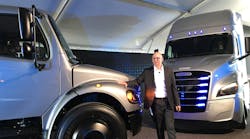AUSTIN, TX. There was no hiding the excitement from Roger Nielsen, president and CEO of Daimler Trucks North America, when speaking about the development of electric trucks.
The progress is happening at a “greater speed than expected,” he said.
When adding in the strong truck market and the continued advancement of the company’s automation push, Nielsen had many reasons to be upbeat during a media roundtable at American Trucking Associations’ annual Management Conference & Exhibition.
Just prior to the conference, Daimler met with about 30 customers who were able to test drive electric trucks. Several customers will be taking delivery of their own electric models for further testing “within days,” he said.
This follows the June unveiling of the all-electric Freightliner eCascadia heavy-duty and Freightliner eM2 medium-duty models. In September, Daimler announced it was leading a $155 million investment in Proterra Inc., a manufacturer of electric charging systems based in California.
Nielsen said he had recently tested out Proterra’s technology in a C2 school bus manufactured by DTNA’s Thomas Built Buses unit. He said he was impressed how quickly it went from 0 to 65 mph, and demonstrated how the Proterra investment was already providing benefits.
In response to a question about a possible delay of deliveries of Tesla’s electric Semi to 2020, Nielsen said it was not just a race to market. “The best battery solution is going to win,” he said of the electric truck market. “It’s all about energy consumption.”
However, he predicted Daimler would have the “highest number” of electric vehicles in the commercial vehicle segment in 2020.
He also downplayed some of the buzz surrounding about the Tesla truck, saying the recent meeting with customers indicated to him they want to be familiar with the overall vehicle, such as what Freightliner offers with the Cascadia.
That helps create “a smooth transition from a diesel-powered truck to an electric-powered truck,” he said.
Nielsen cautioned there remain many steps before electric trucks are a reality, and that the initial business case remains far more likely for smaller vehicles. In addition, questions about charging, residual values, and other issues are still uncertain.
Much more clear was the continued strength of the North American trucking market. The company has a backlog of 125,000 vehicles, and Nielsen said they are taking steps to avoid “speculative orders” from customers. Those could be inflated orders placed ahead of time to ensure they have build slots.
Nielsen also noted the “instability” in the supply chain caused by industywide strength that has “hounded us all year” has mostly stabilized. “Running at peak capacity brings along hiccups,” he said, and at times requires “extreme measures to get parts to factories.”
In the automated driving space, Nielsen said the research center announced in June is up-and-running, and the company is “hiring a lot of folks.” He believes Level 4 automation will offer a “positive business case,” but still doesn’t see the driver being removed from the equation any time soon.
He was a bit less bullish on platooning, saying that it “has some promise for fuel efficiency” but could prove unpopular with some drivers in the trailing vehicles. Some fleets are saying it could be “difficult to find an application that would make sense to equip the whole fleet with that kind of technology,” he said.




